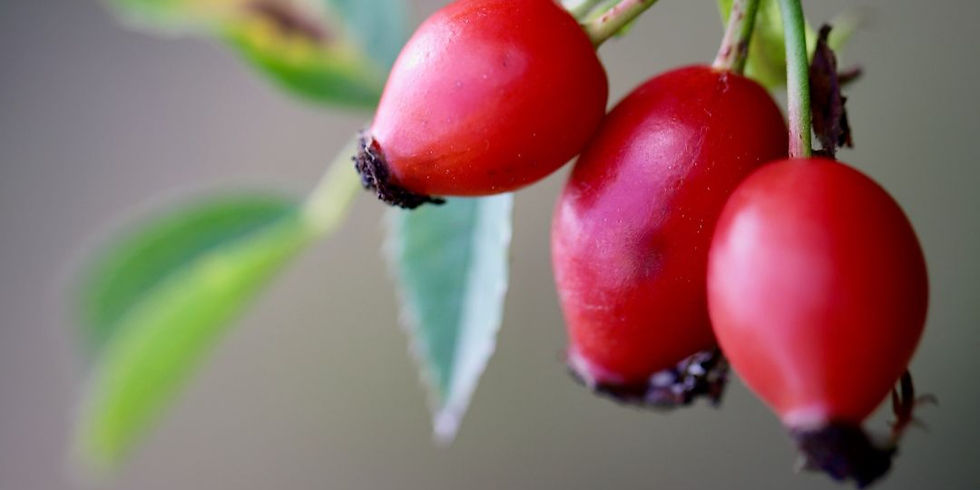Autumn Into Winter: A Walk Through Northern Alberta
- brightgather
- Sep 28
- 3 min read
Just because the leaves have fallen and the frost (and depending on where you are...snow) has started to creep in doesn’t mean nature has gone to sleep. Here in Athabasca, Alberta, October, November, and even December still hold plenty of herbal treasures if you know where to look.

The colours fade, the air turns crisp, and the plants that remain carry a quiet kind of strength - roots packed with energy, berries glowing against the frost, and evergreens bursting with life while everything else rests. This is the season when the forest slows down and whispers its secrets to anyone willing to take a slow, mindful walk.
Basket in hand, you can follow the scent of spruce, the bright pop of rosehips, and the rich soil where dandelion and burdock roots dig deep for winter.
October – The Last Burst of Autumn
October is a beautiful window for late-season harvesting. The air has that perfect crispness, leaves crunch underfoot, and many herbs are at their most potent just before the ground freezes.

Rosehips – Bright red and full of vitamin C, these little fruits are perfect for teas, syrups, or drying to enjoy throughout winter. A light frost sweetens them naturally.
Yarrow – Often still clinging to sunny spots, yarrow leaves can be dried for teas or infused into oils for soothing salves.
Plantain (Broadleaf or Narrowleaf) – Even if the leaves look tired, the roots hold nutrients and can be infused into oils or tinctures for gentle herbal support.
Pine & Spruce Tips – Collect young, soft tips for making fragrant, immune-boosting syrup or a soothing chest balm.
November – Roots and Bark Season
By November, the world above ground has mostly slowed down, but below the surface, life continues. This is prime time for roots and bark that have stored the summer’s energy.

Dandelion Root – Dig these earthy roots for a liver-supporting tea or roast them as a caffeine-free coffee alternative.
Burdock Root – Gentle and nourishing, burdock roots are a staple in herbal winter tonics. Harvest only where plentiful.
Willow Bark – A natural source of salicylates, willow bark can be dried and made into a mild tea to support aches or inflammation.
Cedar & Spruce Resin – Cold weather brings out sticky, healing resins perfect for making salves or a subtle incense.
December – Evergreens
Even when snow blankets the forest floor, evergreens continue to share their gifts.

Spruce & Pine Needles – Brew into a bright, vitamin C–rich tea with a woodsy, refreshing aroma that warms the spirit.
Juniper Berries – Small but potent, juniper berries can flavor winter broths or be used sparingly in tinctures.
Chaga Mushroom – If you’re lucky, you might spot this prized fungus growing on birch. Harvest responsibly and only from abundant sources.
Foraging Tips for the Late Season

Respect the Land: Only take what you need, leaving plenty for wildlife and regrowth.
Know Your Plants: Identify each plant carefully before harvesting. If there’s any doubt, leave it.
Harvest Ethically: Use clean tools, avoid polluted areas, and always thank the land for its gifts.
Even as the days grow shorter and the air turns icy, the forest and fields around Athabasca continue to offer nourishment, medicine, and connection. A quiet walk with a basket and a warm thermos of tea can reveal more abundance than you might expect, and it’s a beautiful way to stay rooted in the rhythm of the seasons.

Turning Your Foraged Treasures Into Winter Comforts
Once you’ve gathered your autumn and early winter herbs, the real magic begins - bringing them into your home in ways that nourish body and spirit.
Rosehips make a bright, tangy tea or a sweet syrup to stir into winter drinks.
Pine and spruce tips can be infused into a warming syrup or steeped for a fragrant, vitamin C–rich tea.
Dandelion and burdock roots can be roasted for a gentle, earthy coffee alternative or simmered into tonics to support digestion and liver health.
Yarrow, plantain, and willow bark can be dried and stored for teas, salves, or infused oils that soothe skin and calm the body.
Juniper berries and Chaga mushroom used sparingly, they add depth and resilience to winter herbal remedies.

rosehip oil
Even in the coldest months, these little gifts from the land remind us that the forest continues to nurture and sustain. Take your time, breathe deeply, and let the quiet wisdom of the late-season wild herbs guide your winter wellness rituals.
Happy foraging, and may your autumn into winter be filled with warmth, wonder, and herbal magic <3 Love, Bright Gather




Comments